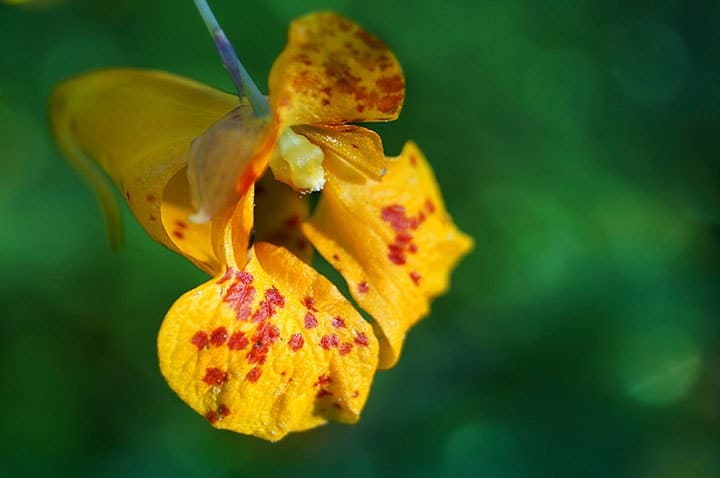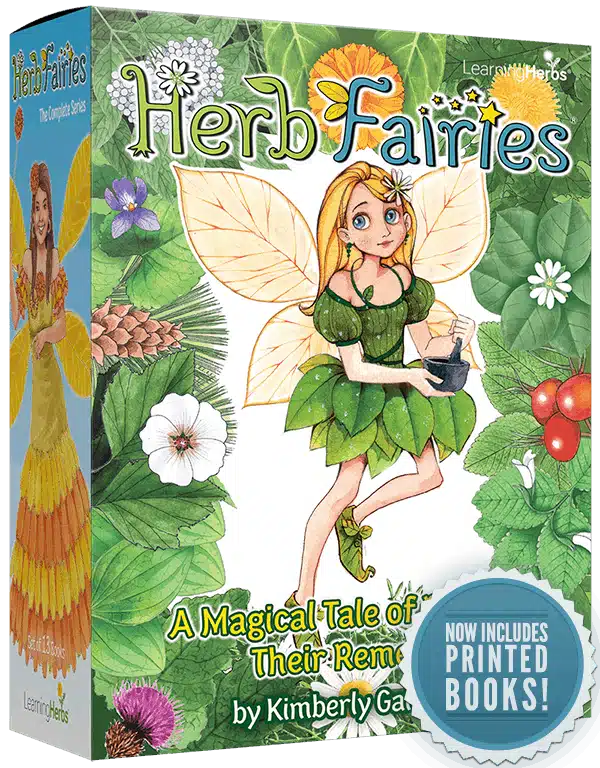Herbalism is my secret passion. I find all the dynamics and intricacies of each plant to be fascinating. After all, herbs have been used medicinally and for pure enjoyment for thousands of years. I, therefore, love using herbs in my homemade soapmaking.
Whether you are a die hard cold-process soapmaker, hot-processor, or just like to do a little melt and pour for fun every now and then, you can include herbs in your soapmaking projects for medicinal purposes, color, exfoliation, or as a decoration to the top.
10 Best Herbs for Soapmaking
Yarrow
While yarrow is often used internally, it is also used topically to fight against inflammation and help heal wounds faster due to its antibacterial and antiseptic properties. This makes it great for acne, eczema, and other skin conditions. Yarrow has tiny white flowers that can be dried and used on top or within soap. Leaves and flowers can be used in an herbal oil infusion and/or tea for the lye water in your soap recipe. It grows throughout North America, so you may find something blooming June through October.

Chamomile
Chamomile has traditionally been used for its calming effect in teas. It is also used topically on scars and wounds as an antibacterial, anti-inflammatory herb that is high in antioxidants. The flowers are very pretty on top of soaps and can give added medicinal properties in a tea infusion. I also like to use the petals mixed in soap for a pretty texture and visual appeal. It can also be infused through oil, giving your soap a slight golden color.

Peppermint
Peppermint is something that is easy to get a hold of or grow (it’ll take over your yard), making it a fun herb to add to soaps. Like other herbs, make sure that you steep the leaves before use so they do not “bleed,” making brown spots in your soap. Peppermint is often used as an exfoliant in soap, but paired with peppermint essential oil, it can create a very invigorating start to the morning.

Lemon Balm
Lemon balm is one of my favorite plants. It doesn’t have showy flowers, but it just looks pretty. Actually, it looks a lot like mint when it is growing, but has a more uniform domed appearance. Recent studies have shown the benefits of lemon balm on cold sores due to the calming, relaxing, effect on the nervous system – making it beneficial for those wanting a calming aromatherapy soap, whether they get cold sores or not.

Calendula
Calendula is another great herb for calming the skin and reducing inflammation. It has beautiful yellow or orange petals that are very pretty within or on top of soap. Make an oil infusion for a golden effect to your soap.

Jewelweed
I make jewelweed soap for poison ivy every year. It blooms by streams and on roadsides everywhere here in Pennsylvania, making it easy to identify and use. It has been shown to dissolve the urushiol oil that poison ivy or poison oak leaves on the skin, making it very valuable to those who suffer severe reactions. It’s not something that you’ll find in dried form online, so if it doesn’t grow near you, then goldenseal is a good substitution if you’re trying to make a poison ivy soap. I infuse the water and the bulk of the oil for soap.
Goldenseal
Goldenseal has pretty three to five lobed leaves with a flower and then fruit sticking seemingly right out of the middle. Because goldenseal is endangered from being over-harvested in the wild, be sure to only use cultivated goldenseal. Goldenseal salves are wonderful for wounds, rashes, itchiness, poison ivy, cold sores, and inflammation. Therefore, using it in soap just seems like common sense. It is sold commonly in capsules, but for soapmaking purposes, using loose-leaf goldenseal or a tea bag for a hot oil and water infusion is much more simple.

Nettle
Nettles are high in vitamins and minerals. Its astringent and anti-inflammatory properties make it excellent for skin and hair. Nettle is anti-inflammatory and is calming for your skin, making it great for acne! It can be infused in oil to give a pretty green color to your soap. The more you use, the darker green it will be.
Lavender
Lavender has always been a very popular herb to use in soapmaking. It will most likely brown when added inside the soap, which is why I like to use it on top where the small, elongated purple flowers make a beautiful addition.

Cornflowers
Cornflowers, or bachelor’s buttons, are very pretty little flowers with a bright purplish blue color. Traditionally they have been used as teas to help eyesight. They are often used today to strengthen maturing skin due to their high antioxidant properties. They will turn a yellow color instead of brown if stirred into the soap, so don’t be afraid to use them that way and leave some sprinkled on the top to retain that beautiful blue spark of color.
While there are so many more herbs to use within soaps (rose petals, comfrey leaf, rosemary, etc.), those are my favorite.
Looking for a way to jump in and use some of these herbs right now?
Here’s a sneak peak at one of the recipes from my book, The Natural Soapmaking Book for Beginners.

Chamomile Tea Soap with Chamomile Flowers
Recipe from The Natural Soapmaking Book for Beginners by Kelly Cable (Althea Press, 2017)
Yield: 3 pounds or twelve 4-ounce bars
Lye Discount: 5%
Label: Vegan, Gentle
Start to Finish Time: 1 to 2 hours, 24 hours insulation, 4 to 6 weeks to cure
Scent: Eucalyptus, Lemon, Cedarwood
Equipment List:
- large stainless steel pot
- large spoon
- scale
- bowls for measuring ingredients
- thermometer
- stick blender
- small zip top bag
- glass or plastic bowl for lye water
- mold
- parchment paper
- rubber spatula
- measuring spoons
- saucepan for hot oil infusion
Ingredients:
- 8 ounces olive oil
- 2 ounces annatto seed infused olive oil
- 10 ounces coconut oil
- 5 ounces cocoa butter
- 5 ounces sweet almond oil
- 2 ounces mango butter
- 4.5 ounces lye
- 12 ounces water
- 0.3 ounces eucalyptus essential oil
- 0.4 ounces lemon essential oil
- 0.3 ounces cedarwood essential oil
- 1 tablespoon or 1 tea bag of chamomile leaves
- 2 tablespoons dried chamomile flowers
Safety First!
- Remember to wear your safety equipment and mix the lye water outside.
- Tell everyone you live with that where you’re working is off limits.
- Give yourself enough time to complete the recipe.
Prep-Ahead:
1. Create an annatto seed infusion in olive oil using the hot or cold method. For a hot infusion, place 1 heaping tablespoon of annatto seeds in 8 ounces of oil and heat on low to 250°F for about 20 minutes, stirring occasionally. Turn off and allow to cool to room temperature. For a cold infusion, place 1 heaping tablespoon of annatto seeds in 8 ounces of olive oil and set on windowsill for 6 weeks, shaking occasionally.
2. Steep chamomile tea leaves in hot water for 20 minutes. Remove tea leaves and allow to drain. Drink the tea and save the tea leaves for the recipe.
Instructions:
1. Heat the Fats/Oils: In a large pot over medium-low heat, combine olive oil, annatto seed infused olive oil, coconut oil, cocoa butter, sweet almond oil, mango butter. Heat until they are melted and incorporated. Remove from heat and allow to cool to 100-110°F.
2. Mix the Lye-Water: Put on protective gear including a mask, gloves, and long sleeves. Outside, carefully add the lye crystals to the very cold water and stir until dissolved. Allow to cool to 100-110°F. If oil or lye water cool at different rates, you can use a cold or hot water bath in the sink.
3. Prepare the Mold: While the oils and lye water cool, line the mold with parchment paper.
4. Combine and Bring to Trace: When both oils and lye water are around 100-110°F, pour the lye water into the pot of oils. Use a stick blender or hand mixer to mix for 1 to 2 minutes and then let the mixture rest for 4 to 5 minutes. Repeat mixing and resting until light trace.
5. Mix in Natural Additives: When soap reaches light trace, add essential oil and 1 tablespoon of the used chamomile tea leaves and blend for 30 seconds.
6. Mold the Soap: Pour the soap mixture into the mold. Sprinkle with chamomile flowers. Using a glove, gently pat flowers so that they adhere to the soap. Cover with a lid or parchment paper and insulate with a blanket for 24 hours.
7. Cut and Cure: Remove soap from the mold. If it seems too soft to remove, wait another 12 to 24 hours before removing. Cut the soap into twelve 4-ounce bars. Allow the bars to cure for 4 to 6 weeks.
Tip: Sometimes moisture left within herbs can bleed into the soap over time, leaving a brown halo. This is why you need to make sure your tea leaves are drained of color before adding to soap. If a brown spot occurs you can still use the soap. It’s purely cosmetic.













Hi Kelly, I have wondered for a long time if the potency of herbs survive the saponification process. Is there any reason to believe that the oil infusion experiences a degradation during the chemical reaction of soap making? I have shied away from making herbal soap because herbal creams and salves work so well, what is an argument for making herbal soaps? They get washed off fairly quickly, is it really worth the effort?